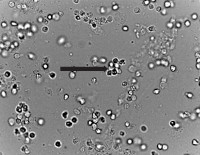Detection of Tritrichomonas foetus in Cattle at the Kumasi Abattoir https://dx.doi.org/10.4314/njpar.v43i1.6
Main Article Content
Abstract
The study was conducted to determine the prevalence of Tritrichomonas foetus in slaughtered cattle at the Kumasi abattoir. A total of one hundred (100) slaughtered cattle were sampled randomly (60-bulls and 40 cows) with preputial wash and vaginal lavage collected after slaughter for laboratory analysis using Wet-mount technique. Data obtained were analyzed by descriptive statistics using MS Excel and the results expressed in percentages and graphs. The prevalence of bovine Tritrichomoniasis was 34% with the cows recording 20% and the bulls 14% of the sampled population. Out of the cows sampled, twenty (20) were positive representing 50% and out of the bulls sampled, fourteen (14) were positive representing 23.3%. This clearly shows that cows had the highest prevalence compared to the bulls, therefore sex has a significant effect on the infection, since p˂0.05. The WASH and the Zebu cattle had relatively higher % positivity of 41.7% and 40.7%. N’dama cattle recorded 28.6% positivity which was same as the 28.6% positivity in the White Fulani, while the Sanga breed recorded the least positivity (21.4%) of the infection. Breed of cattle however had no significant effect on infection (p>0.05). The highest prevalence of Tritrichomonas infection was 47.2% in adult cattle of 4 years old whiles adult cattle of 3 years old had a prevalence rate of 28.6% whereas cattle of 2 years of age recorded the lowest prevalence rate of 22.7%. However, age had no significant effect (p>0.05) on the infection. Further studies should be conducted to ascertain the rate of infection in the country by using a larger sample size. In order to reduce the level of infection it is advisable to screen all breeding bulls and cull the affected ones.
Article Details

This work is licensed under a Creative Commons Attribution-NonCommercial-NoDerivatives 4.0 International License.
References
Kalemera, G.R. (2010). Factors Affecting the Level of Commercialization among Cattle Keepers in the Pastoral Areas of Uganda. M. Phil. Thesis, University of Makerere.
Food and Agricultural Organization (2009). FAOSTAT data. Food and Agriculture Organization (FAO), Rome. www.fao.org/faostat/
Ministry of Food and Agriculture (MoFA). (2002). Food and Agriculture Sector Development Policy. Delaram Ltd. Accra. pp. 58-61.
Abuom, T.O. (2006). Periparturient conditions in small-holder dairy cattle herds in Kikuyu Division of Kiambu District, Kenya. M.Sc. thesis. University of Nairobi.
Givens, M.D., and Marley, M.S.D. (2008). Infectious causes of embryonic and fetal mortality. Theriogenology. 70: 270-285.
Daly, R. (2007). Control of Infectious Reproductive Disease: The Role of Biosecurity. Applied Reproductive Strategies in Beef Cattle Proceedings September. 11: 197-208.
Wagari, A., and Shiferaw, J. (2015). Major Reproductive Health Problems of Dairy Cows at Horro Guduru Animal Breedingand Research Center, Horro GuduruWollega Zone, Ethiopia.
Irons, P.C., Henton, M.M., and Bertschinger, H.J. (2002). Collection of preputial material by scraping and aspiration for the diagnosis of Tritrichomonas foetus in bulls. Journal of the South African Veterinary Association. 73:66-69.
Stevenson, J.S. (2005). Breeding strategies to optimize reproductive efficiency in dairy herds. Veterinary Clinics of North America: Food Animal Practice. 21: 349-365.
BonDurant, R.H. (2005). Venereal diseases of cattle: Natural history, diagnosis and the role of vaccines in their control. Veterinary
Clinics of North America: Food Animal Practice. 21:383–408. 11. Mekonen, H., Kalayou, S., and Kyule, M. (2010). Serological survey of bovine
brucellosis in Barka and Orado breeds (Bosindicus) of western Tigray, Ethiopia. Preventive Veterinary Medicine. 94:28-35.
Kaltungo, B.Y. and Musa, I.W. (2013). A Review of Some Protozoan Parasites Causing Infertility in Farm Animals. ISRN Tropical Medicine.
Mai, H.M., Irons, P.C., Kabir, J., and Thompson P.N. (2013). Prevalence of bovine genital campylobacteriosis and Trichomonosis of bulls in northern Nigeria.Acta Veterinaria Scandinavica. 55:56.
Asare, D.A., Emikpe, B.O., Folitse, R.D., and Burimuah, V. (2016). Incidence and pattern of pneumonia in goats slaughtered at the Kumasi Abattoir, Ghana. African Journal of Biomedical Research. 19(1).
Jeremiah, O.T., Ojo, N.A. and Otesile, E.B. (2002). Estimation of Age of Cattle in Nigeria Using Rostral Dentition: Short Communication. Tropical Veterinarian.20.10.
Karnuah, A.B., Dunga, G., Wennah, A., Wiles, W.T., Greaves, E., Varkpeh, R., Osei-Amponsah, R., and Boettcher, P. (2018). Phenotypic characterization of beef cattle breeds and production practices in Liberia. Tropical Animal Health Production. 50(6):1287-1294.
Pereira-Neves, A., Campero, C., Martínez, A., and Benchimol, M. (2010). Identification of Tritrichomonas foetus pseudocysts in fresh preputial secretion samples from bulls. Veterinary parasitology. 175. 1-8.
Mendoza-Ibarra, J.A., Pedraza-Dı´az, S., Garcı´a-Pen˜a, F.J., Rojo-Montejo, S., Ruiz-Santa-Quiteria, J.A., San MiguelIba´n˜ ez, E., Navarro-Lozano, V., Ortega-Mora, L.M., Osoro, K., and Collantes-Fernandez, E. (2012). High prevalence of Tritrichomonas foetus infection in Asturiana de la Montan˜a beef cattle kept in extensive conditions in Northern Spain. Veterinary Journal. 193:146–151.
Rae, D.O., Crews, J.E., Greiner, E.C., and Donovan, G.A. (2004). Epidemiology of Tritrichomonas foetus in beef bull populations in Florida. Theriogenology. 61: 605-618.
Speer, C.A., and White, M.W. (1991). Bovine trichomoniasis. Large Animal Veterinary. 46:18–20.
Kvasnicka, W.G., Hall, M.R., and Hanks, D.R. (1999). Bovine Trichomoniasis. In: Howard JL, editor. Current Veterinary Therapy 4: Food Animal Practice. Philadelphia: W.B. Saunders Co.; 1999. p. 420-5.
Mutto, A.A., Giambiaggi, S., and Angel, S. O. (2006). PCR detection of Tritrichomonas foetus in preputial bull fluid without prior DNA isolation. Veterinary Parasitology. 136, 357–361.


